Global Supply Chain Management: Automotive Industry Strategies Report
VerifiedAdded on 2021/02/19
|11
|3676
|47
Report
AI Summary
This report delves into the intricacies of global supply chain management within the automotive industry. It examines the design and implementation of supply chain strategies, including the application of lean principles and agility to enhance efficiency. The report highlights how automotive companies configure their supply chains through collaboration, emphasizing the role of advanced technologies in maintaining competitive advantages. The analysis covers strategic, tactical, and operational aspects of supply chain management, providing insights into inventory velocity, lean logistics, and the integration of technology, exemplified by case studies of companies like Tesla and Toyota. The report also explores the utilization of advanced technologies, such as cloud computing and big data analytics, to optimize business processes and gain a competitive edge. The study underscores the importance of aligning supply chain strategies with overall business objectives to achieve desired outcomes and improve profitability. The report concludes by emphasizing the critical role of technology in streamlining operations and reducing costs, which ultimately contributes to improved profitability and a stronger competitive position in the automotive sector.

Global Supply Chain
Management
Management
Paraphrase This Document
Need a fresh take? Get an instant paraphrase of this document with our AI Paraphraser
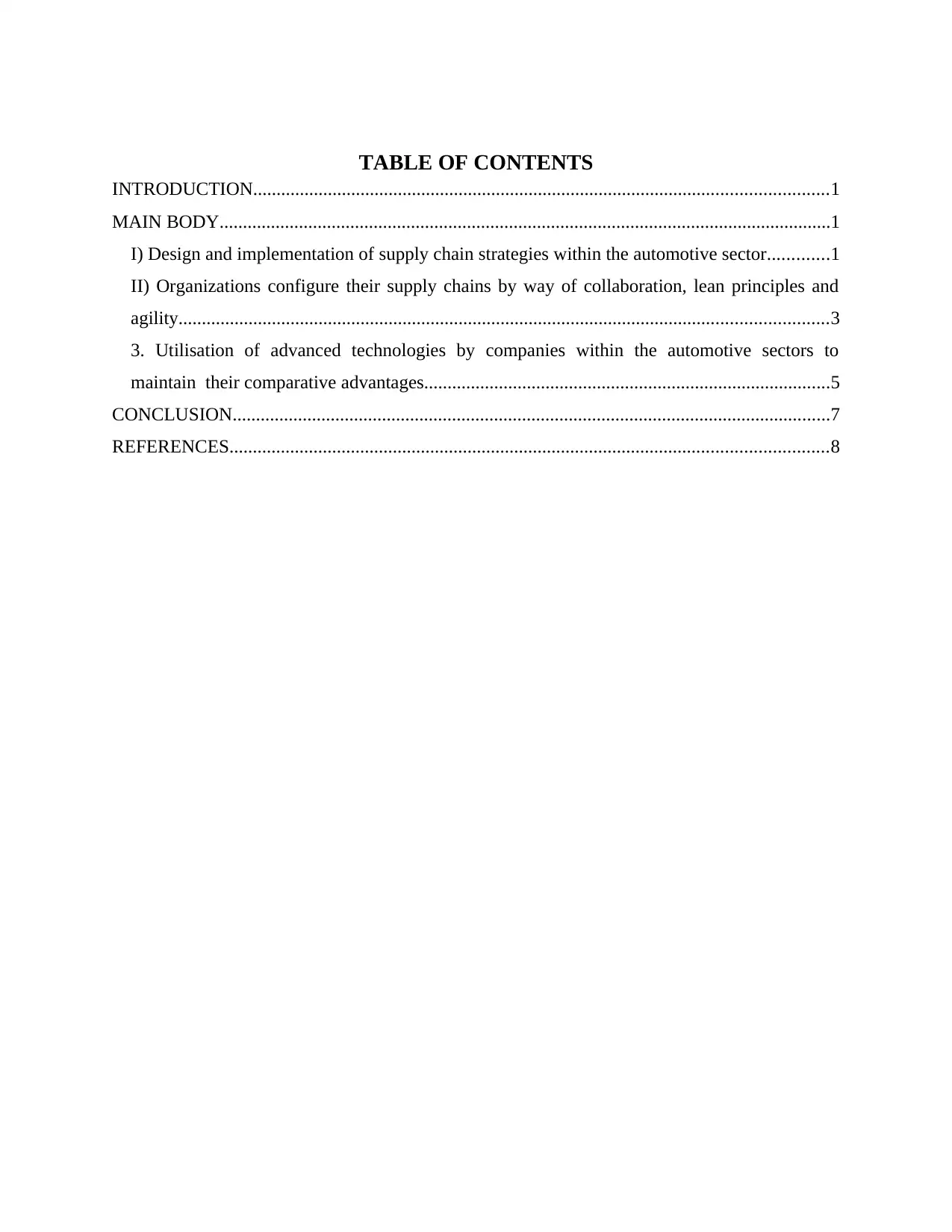
TABLE OF CONTENTS
INTRODUCTION...........................................................................................................................1
MAIN BODY...................................................................................................................................1
I) Design and implementation of supply chain strategies within the automotive sector.............1
II) Organizations configure their supply chains by way of collaboration, lean principles and
agility...........................................................................................................................................3
3. Utilisation of advanced technologies by companies within the automotive sectors to
maintain their comparative advantages.......................................................................................5
CONCLUSION................................................................................................................................7
REFERENCES................................................................................................................................8
INTRODUCTION...........................................................................................................................1
MAIN BODY...................................................................................................................................1
I) Design and implementation of supply chain strategies within the automotive sector.............1
II) Organizations configure their supply chains by way of collaboration, lean principles and
agility...........................................................................................................................................3
3. Utilisation of advanced technologies by companies within the automotive sectors to
maintain their comparative advantages.......................................................................................5
CONCLUSION................................................................................................................................7
REFERENCES................................................................................................................................8
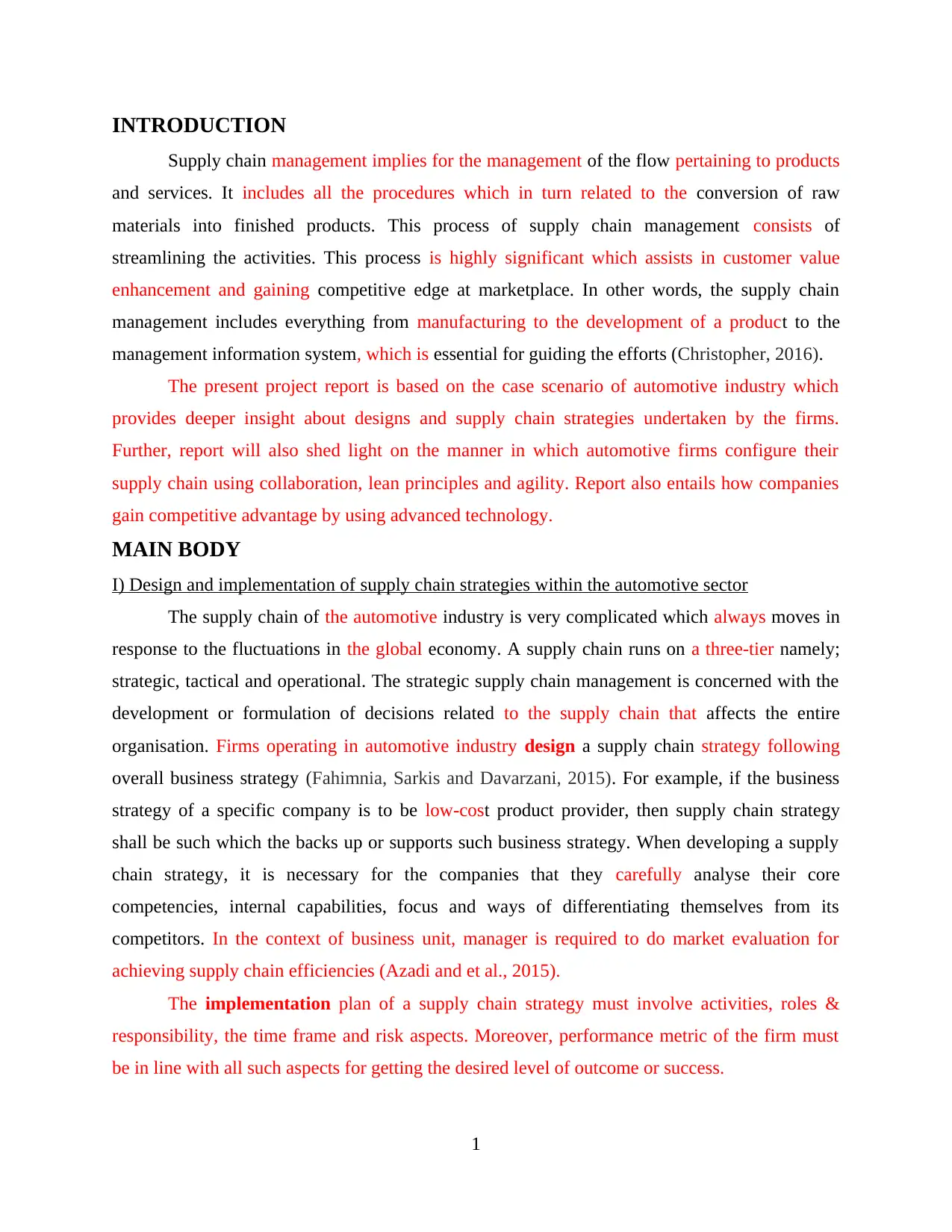
INTRODUCTION
Supply chain management implies for the management of the flow pertaining to products
and services. It includes all the procedures which in turn related to the conversion of raw
materials into finished products. This process of supply chain management consists of
streamlining the activities. This process is highly significant which assists in customer value
enhancement and gaining competitive edge at marketplace. In other words, the supply chain
management includes everything from manufacturing to the development of a product to the
management information system, which is essential for guiding the efforts (Christopher, 2016).
The present project report is based on the case scenario of automotive industry which
provides deeper insight about designs and supply chain strategies undertaken by the firms.
Further, report will also shed light on the manner in which automotive firms configure their
supply chain using collaboration, lean principles and agility. Report also entails how companies
gain competitive advantage by using advanced technology.
MAIN BODY
I) Design and implementation of supply chain strategies within the automotive sector
The supply chain of the automotive industry is very complicated which always moves in
response to the fluctuations in the global economy. A supply chain runs on a three-tier namely;
strategic, tactical and operational. The strategic supply chain management is concerned with the
development or formulation of decisions related to the supply chain that affects the entire
organisation. Firms operating in automotive industry design a supply chain strategy following
overall business strategy (Fahimnia, Sarkis and Davarzani, 2015). For example, if the business
strategy of a specific company is to be low-cost product provider, then supply chain strategy
shall be such which the backs up or supports such business strategy. When developing a supply
chain strategy, it is necessary for the companies that they carefully analyse their core
competencies, internal capabilities, focus and ways of differentiating themselves from its
competitors. In the context of business unit, manager is required to do market evaluation for
achieving supply chain efficiencies (Azadi and et al., 2015).
The implementation plan of a supply chain strategy must involve activities, roles &
responsibility, the time frame and risk aspects. Moreover, performance metric of the firm must
be in line with all such aspects for getting the desired level of outcome or success.
1
Supply chain management implies for the management of the flow pertaining to products
and services. It includes all the procedures which in turn related to the conversion of raw
materials into finished products. This process of supply chain management consists of
streamlining the activities. This process is highly significant which assists in customer value
enhancement and gaining competitive edge at marketplace. In other words, the supply chain
management includes everything from manufacturing to the development of a product to the
management information system, which is essential for guiding the efforts (Christopher, 2016).
The present project report is based on the case scenario of automotive industry which
provides deeper insight about designs and supply chain strategies undertaken by the firms.
Further, report will also shed light on the manner in which automotive firms configure their
supply chain using collaboration, lean principles and agility. Report also entails how companies
gain competitive advantage by using advanced technology.
MAIN BODY
I) Design and implementation of supply chain strategies within the automotive sector
The supply chain of the automotive industry is very complicated which always moves in
response to the fluctuations in the global economy. A supply chain runs on a three-tier namely;
strategic, tactical and operational. The strategic supply chain management is concerned with the
development or formulation of decisions related to the supply chain that affects the entire
organisation. Firms operating in automotive industry design a supply chain strategy following
overall business strategy (Fahimnia, Sarkis and Davarzani, 2015). For example, if the business
strategy of a specific company is to be low-cost product provider, then supply chain strategy
shall be such which the backs up or supports such business strategy. When developing a supply
chain strategy, it is necessary for the companies that they carefully analyse their core
competencies, internal capabilities, focus and ways of differentiating themselves from its
competitors. In the context of business unit, manager is required to do market evaluation for
achieving supply chain efficiencies (Azadi and et al., 2015).
The implementation plan of a supply chain strategy must involve activities, roles &
responsibility, the time frame and risk aspects. Moreover, performance metric of the firm must
be in line with all such aspects for getting the desired level of outcome or success.
1
⊘ This is a preview!⊘
Do you want full access?
Subscribe today to unlock all pages.

Trusted by 1+ million students worldwide
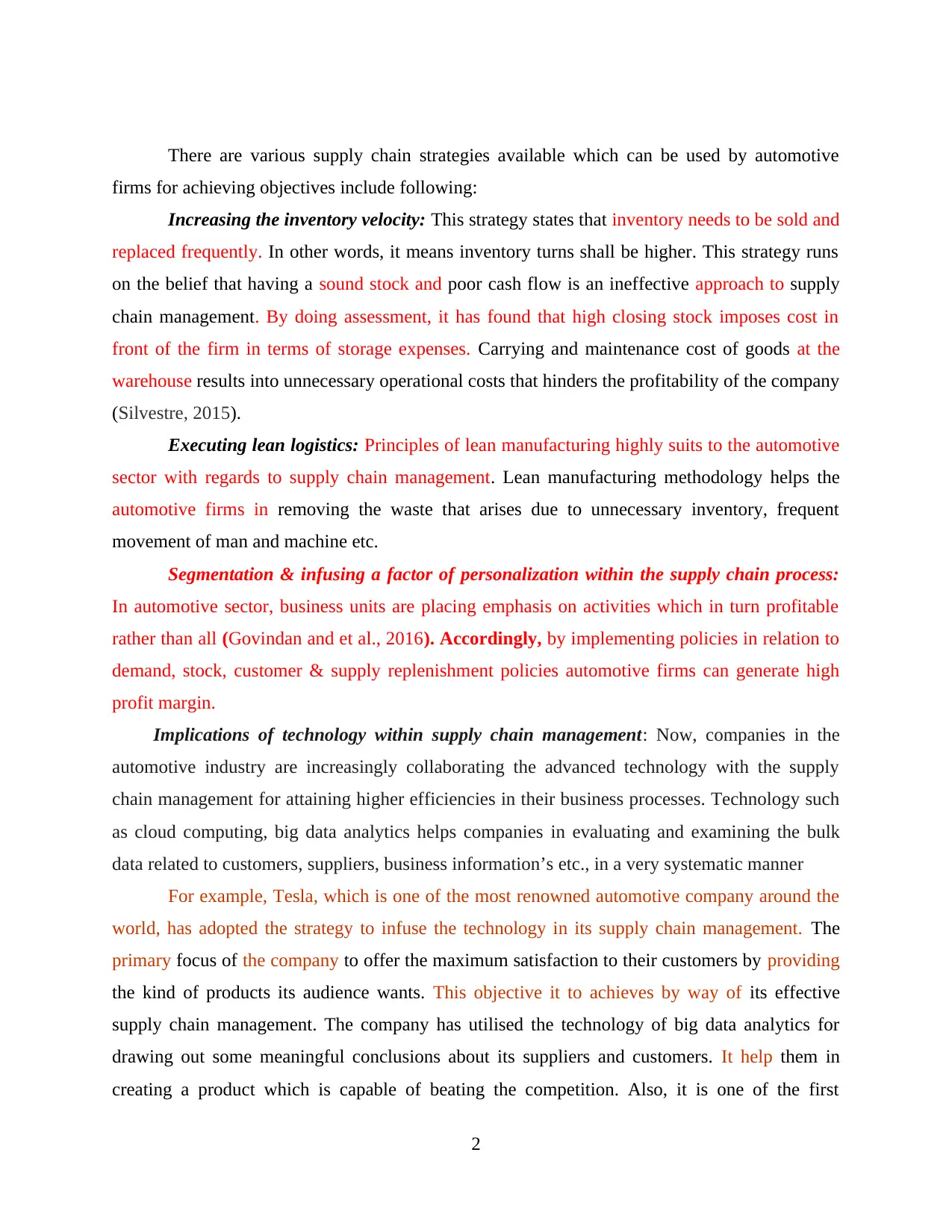
There are various supply chain strategies available which can be used by automotive
firms for achieving objectives include following:
Increasing the inventory velocity: This strategy states that inventory needs to be sold and
replaced frequently. In other words, it means inventory turns shall be higher. This strategy runs
on the belief that having a sound stock and poor cash flow is an ineffective approach to supply
chain management. By doing assessment, it has found that high closing stock imposes cost in
front of the firm in terms of storage expenses. Carrying and maintenance cost of goods at the
warehouse results into unnecessary operational costs that hinders the profitability of the company
(Silvestre, 2015).
Executing lean logistics: Principles of lean manufacturing highly suits to the automotive
sector with regards to supply chain management. Lean manufacturing methodology helps the
automotive firms in removing the waste that arises due to unnecessary inventory, frequent
movement of man and machine etc.
Segmentation & infusing a factor of personalization within the supply chain process:
In automotive sector, business units are placing emphasis on activities which in turn profitable
rather than all (Govindan and et al., 2016). Accordingly, by implementing policies in relation to
demand, stock, customer & supply replenishment policies automotive firms can generate high
profit margin.
Implications of technology within supply chain management: Now, companies in the
automotive industry are increasingly collaborating the advanced technology with the supply
chain management for attaining higher efficiencies in their business processes. Technology such
as cloud computing, big data analytics helps companies in evaluating and examining the bulk
data related to customers, suppliers, business information’s etc., in a very systematic manner
For example, Tesla, which is one of the most renowned automotive company around the
world, has adopted the strategy to infuse the technology in its supply chain management. The
primary focus of the company to offer the maximum satisfaction to their customers by providing
the kind of products its audience wants. This objective it to achieves by way of its effective
supply chain management. The company has utilised the technology of big data analytics for
drawing out some meaningful conclusions about its suppliers and customers. It help them in
creating a product which is capable of beating the competition. Also, it is one of the first
2
firms for achieving objectives include following:
Increasing the inventory velocity: This strategy states that inventory needs to be sold and
replaced frequently. In other words, it means inventory turns shall be higher. This strategy runs
on the belief that having a sound stock and poor cash flow is an ineffective approach to supply
chain management. By doing assessment, it has found that high closing stock imposes cost in
front of the firm in terms of storage expenses. Carrying and maintenance cost of goods at the
warehouse results into unnecessary operational costs that hinders the profitability of the company
(Silvestre, 2015).
Executing lean logistics: Principles of lean manufacturing highly suits to the automotive
sector with regards to supply chain management. Lean manufacturing methodology helps the
automotive firms in removing the waste that arises due to unnecessary inventory, frequent
movement of man and machine etc.
Segmentation & infusing a factor of personalization within the supply chain process:
In automotive sector, business units are placing emphasis on activities which in turn profitable
rather than all (Govindan and et al., 2016). Accordingly, by implementing policies in relation to
demand, stock, customer & supply replenishment policies automotive firms can generate high
profit margin.
Implications of technology within supply chain management: Now, companies in the
automotive industry are increasingly collaborating the advanced technology with the supply
chain management for attaining higher efficiencies in their business processes. Technology such
as cloud computing, big data analytics helps companies in evaluating and examining the bulk
data related to customers, suppliers, business information’s etc., in a very systematic manner
For example, Tesla, which is one of the most renowned automotive company around the
world, has adopted the strategy to infuse the technology in its supply chain management. The
primary focus of the company to offer the maximum satisfaction to their customers by providing
the kind of products its audience wants. This objective it to achieves by way of its effective
supply chain management. The company has utilised the technology of big data analytics for
drawing out some meaningful conclusions about its suppliers and customers. It help them in
creating a product which is capable of beating the competition. Also, it is one of the first
2
Paraphrase This Document
Need a fresh take? Get an instant paraphrase of this document with our AI Paraphraser
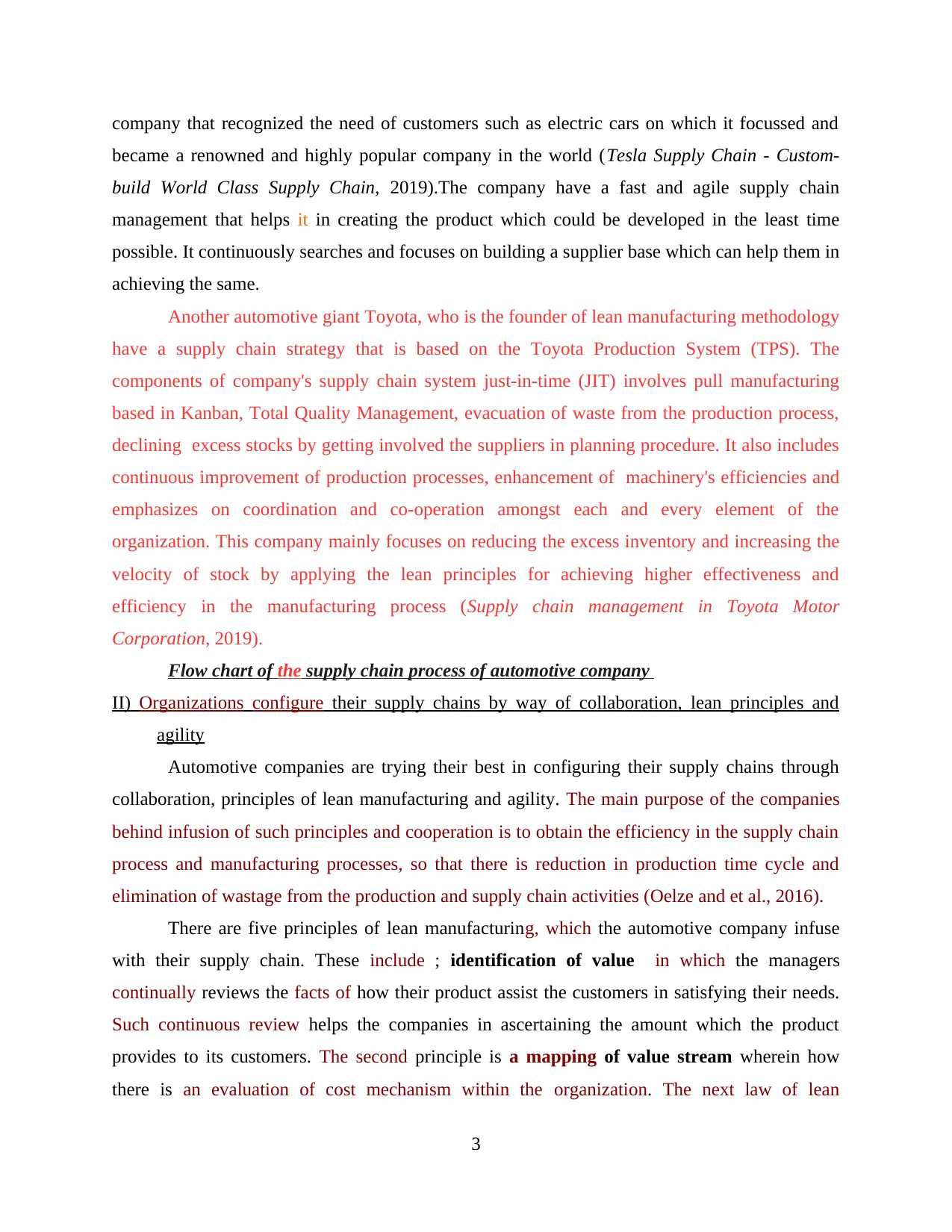
company that recognized the need of customers such as electric cars on which it focussed and
became a renowned and highly popular company in the world (Tesla Supply Chain - Custom-
build World Class Supply Chain, 2019).The company have a fast and agile supply chain
management that helps it in creating the product which could be developed in the least time
possible. It continuously searches and focuses on building a supplier base which can help them in
achieving the same.
Another automotive giant Toyota, who is the founder of lean manufacturing methodology
have a supply chain strategy that is based on the Toyota Production System (TPS). The
components of company's supply chain system just-in-time (JIT) involves pull manufacturing
based in Kanban, Total Quality Management, evacuation of waste from the production process,
declining excess stocks by getting involved the suppliers in planning procedure. It also includes
continuous improvement of production processes, enhancement of machinery's efficiencies and
emphasizes on coordination and co-operation amongst each and every element of the
organization. This company mainly focuses on reducing the excess inventory and increasing the
velocity of stock by applying the lean principles for achieving higher effectiveness and
efficiency in the manufacturing process (Supply chain management in Toyota Motor
Corporation, 2019).
Flow chart of the supply chain process of automotive company
II) Organizations configure their supply chains by way of collaboration, lean principles and
agility
Automotive companies are trying their best in configuring their supply chains through
collaboration, principles of lean manufacturing and agility. The main purpose of the companies
behind infusion of such principles and cooperation is to obtain the efficiency in the supply chain
process and manufacturing processes, so that there is reduction in production time cycle and
elimination of wastage from the production and supply chain activities (Oelze and et al., 2016).
There are five principles of lean manufacturing, which the automotive company infuse
with their supply chain. These include ; identification of value in which the managers
continually reviews the facts of how their product assist the customers in satisfying their needs.
Such continuous review helps the companies in ascertaining the amount which the product
provides to its customers. The second principle is a mapping of value stream wherein how
there is an evaluation of cost mechanism within the organization. The next law of lean
3
became a renowned and highly popular company in the world (Tesla Supply Chain - Custom-
build World Class Supply Chain, 2019).The company have a fast and agile supply chain
management that helps it in creating the product which could be developed in the least time
possible. It continuously searches and focuses on building a supplier base which can help them in
achieving the same.
Another automotive giant Toyota, who is the founder of lean manufacturing methodology
have a supply chain strategy that is based on the Toyota Production System (TPS). The
components of company's supply chain system just-in-time (JIT) involves pull manufacturing
based in Kanban, Total Quality Management, evacuation of waste from the production process,
declining excess stocks by getting involved the suppliers in planning procedure. It also includes
continuous improvement of production processes, enhancement of machinery's efficiencies and
emphasizes on coordination and co-operation amongst each and every element of the
organization. This company mainly focuses on reducing the excess inventory and increasing the
velocity of stock by applying the lean principles for achieving higher effectiveness and
efficiency in the manufacturing process (Supply chain management in Toyota Motor
Corporation, 2019).
Flow chart of the supply chain process of automotive company
II) Organizations configure their supply chains by way of collaboration, lean principles and
agility
Automotive companies are trying their best in configuring their supply chains through
collaboration, principles of lean manufacturing and agility. The main purpose of the companies
behind infusion of such principles and cooperation is to obtain the efficiency in the supply chain
process and manufacturing processes, so that there is reduction in production time cycle and
elimination of wastage from the production and supply chain activities (Oelze and et al., 2016).
There are five principles of lean manufacturing, which the automotive company infuse
with their supply chain. These include ; identification of value in which the managers
continually reviews the facts of how their product assist the customers in satisfying their needs.
Such continuous review helps the companies in ascertaining the amount which the product
provides to its customers. The second principle is a mapping of value stream wherein how
there is an evaluation of cost mechanism within the organization. The next law of lean
3
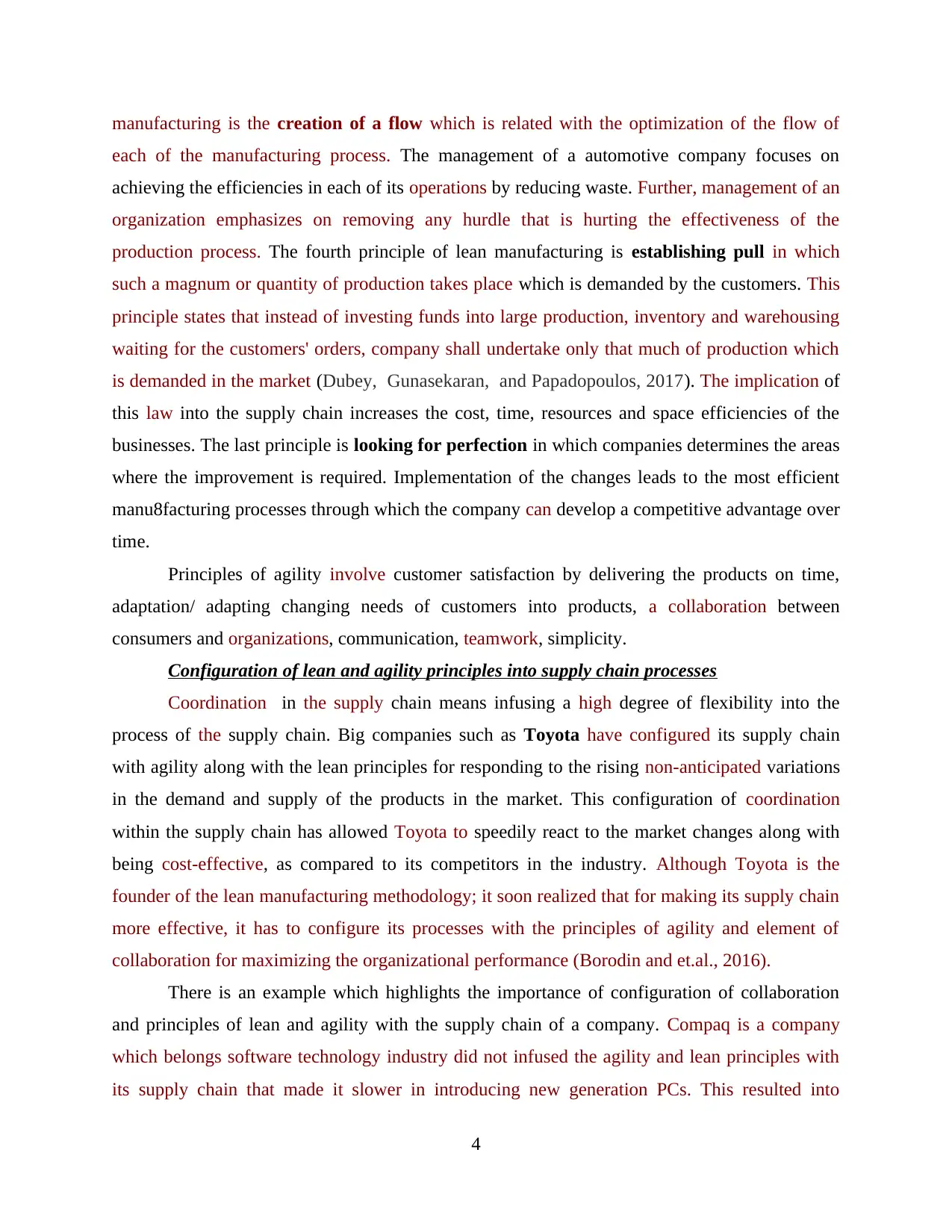
manufacturing is the creation of a flow which is related with the optimization of the flow of
each of the manufacturing process. The management of a automotive company focuses on
achieving the efficiencies in each of its operations by reducing waste. Further, management of an
organization emphasizes on removing any hurdle that is hurting the effectiveness of the
production process. The fourth principle of lean manufacturing is establishing pull in which
such a magnum or quantity of production takes place which is demanded by the customers. This
principle states that instead of investing funds into large production, inventory and warehousing
waiting for the customers' orders, company shall undertake only that much of production which
is demanded in the market (Dubey, Gunasekaran, and Papadopoulos, 2017). The implication of
this law into the supply chain increases the cost, time, resources and space efficiencies of the
businesses. The last principle is looking for perfection in which companies determines the areas
where the improvement is required. Implementation of the changes leads to the most efficient
manu8facturing processes through which the company can develop a competitive advantage over
time.
Principles of agility involve customer satisfaction by delivering the products on time,
adaptation/ adapting changing needs of customers into products, a collaboration between
consumers and organizations, communication, teamwork, simplicity.
Configuration of lean and agility principles into supply chain processes
Coordination in the supply chain means infusing a high degree of flexibility into the
process of the supply chain. Big companies such as Toyota have configured its supply chain
with agility along with the lean principles for responding to the rising non-anticipated variations
in the demand and supply of the products in the market. This configuration of coordination
within the supply chain has allowed Toyota to speedily react to the market changes along with
being cost-effective, as compared to its competitors in the industry. Although Toyota is the
founder of the lean manufacturing methodology; it soon realized that for making its supply chain
more effective, it has to configure its processes with the principles of agility and element of
collaboration for maximizing the organizational performance (Borodin and et.al., 2016).
There is an example which highlights the importance of configuration of collaboration
and principles of lean and agility with the supply chain of a company. Compaq is a company
which belongs software technology industry did not infused the agility and lean principles with
its supply chain that made it slower in introducing new generation PCs. This resulted into
4
each of the manufacturing process. The management of a automotive company focuses on
achieving the efficiencies in each of its operations by reducing waste. Further, management of an
organization emphasizes on removing any hurdle that is hurting the effectiveness of the
production process. The fourth principle of lean manufacturing is establishing pull in which
such a magnum or quantity of production takes place which is demanded by the customers. This
principle states that instead of investing funds into large production, inventory and warehousing
waiting for the customers' orders, company shall undertake only that much of production which
is demanded in the market (Dubey, Gunasekaran, and Papadopoulos, 2017). The implication of
this law into the supply chain increases the cost, time, resources and space efficiencies of the
businesses. The last principle is looking for perfection in which companies determines the areas
where the improvement is required. Implementation of the changes leads to the most efficient
manu8facturing processes through which the company can develop a competitive advantage over
time.
Principles of agility involve customer satisfaction by delivering the products on time,
adaptation/ adapting changing needs of customers into products, a collaboration between
consumers and organizations, communication, teamwork, simplicity.
Configuration of lean and agility principles into supply chain processes
Coordination in the supply chain means infusing a high degree of flexibility into the
process of the supply chain. Big companies such as Toyota have configured its supply chain
with agility along with the lean principles for responding to the rising non-anticipated variations
in the demand and supply of the products in the market. This configuration of coordination
within the supply chain has allowed Toyota to speedily react to the market changes along with
being cost-effective, as compared to its competitors in the industry. Although Toyota is the
founder of the lean manufacturing methodology; it soon realized that for making its supply chain
more effective, it has to configure its processes with the principles of agility and element of
collaboration for maximizing the organizational performance (Borodin and et.al., 2016).
There is an example which highlights the importance of configuration of collaboration
and principles of lean and agility with the supply chain of a company. Compaq is a company
which belongs software technology industry did not infused the agility and lean principles with
its supply chain that made it slower in introducing new generation PCs. This resulted into
4
⊘ This is a preview!⊘
Do you want full access?
Subscribe today to unlock all pages.

Trusted by 1+ million students worldwide
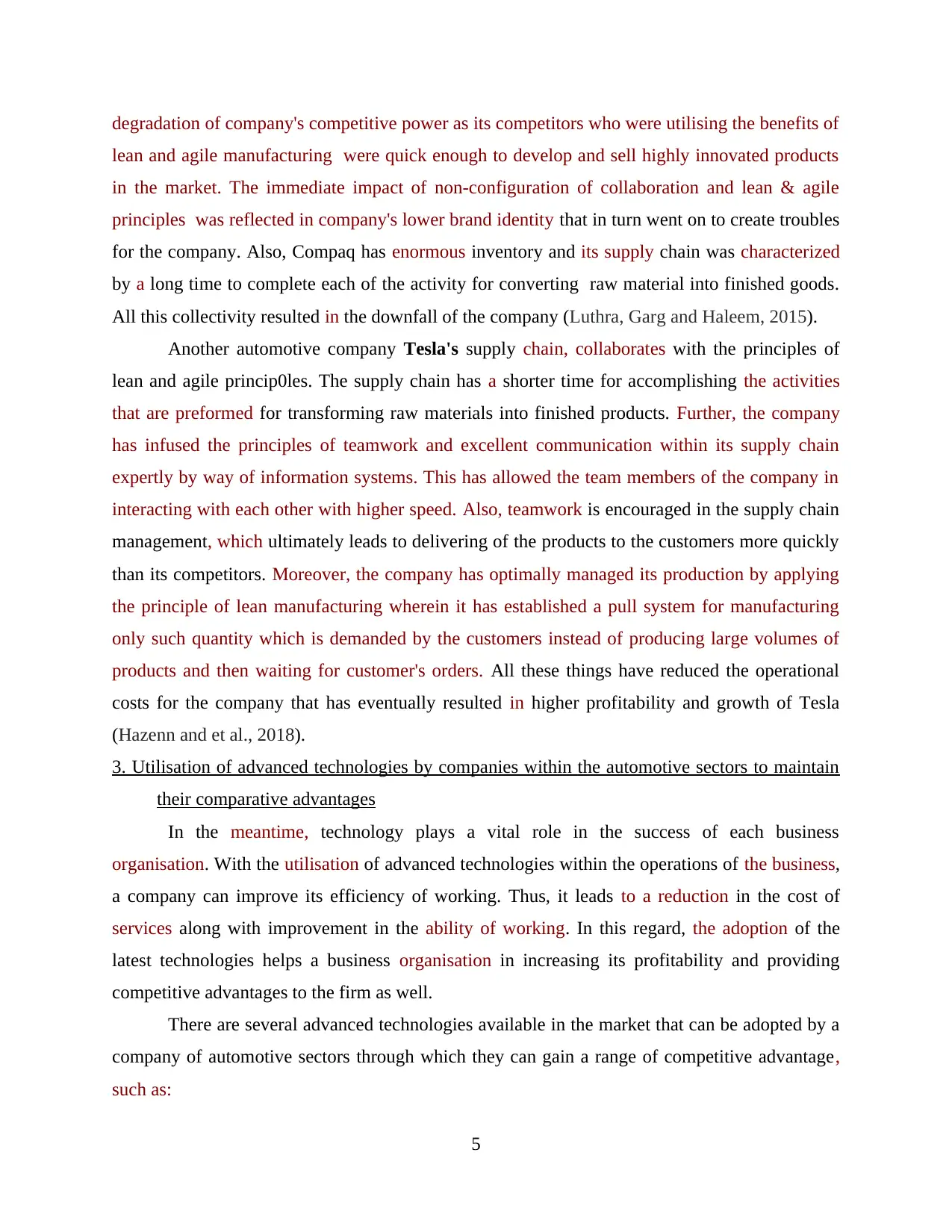
degradation of company's competitive power as its competitors who were utilising the benefits of
lean and agile manufacturing were quick enough to develop and sell highly innovated products
in the market. The immediate impact of non-configuration of collaboration and lean & agile
principles was reflected in company's lower brand identity that in turn went on to create troubles
for the company. Also, Compaq has enormous inventory and its supply chain was characterized
by a long time to complete each of the activity for converting raw material into finished goods.
All this collectivity resulted in the downfall of the company (Luthra, Garg and Haleem, 2015).
Another automotive company Tesla's supply chain, collaborates with the principles of
lean and agile princip0les. The supply chain has a shorter time for accomplishing the activities
that are preformed for transforming raw materials into finished products. Further, the company
has infused the principles of teamwork and excellent communication within its supply chain
expertly by way of information systems. This has allowed the team members of the company in
interacting with each other with higher speed. Also, teamwork is encouraged in the supply chain
management, which ultimately leads to delivering of the products to the customers more quickly
than its competitors. Moreover, the company has optimally managed its production by applying
the principle of lean manufacturing wherein it has established a pull system for manufacturing
only such quantity which is demanded by the customers instead of producing large volumes of
products and then waiting for customer's orders. All these things have reduced the operational
costs for the company that has eventually resulted in higher profitability and growth of Tesla
(Hazenn and et al., 2018).
3. Utilisation of advanced technologies by companies within the automotive sectors to maintain
their comparative advantages
In the meantime, technology plays a vital role in the success of each business
organisation. With the utilisation of advanced technologies within the operations of the business,
a company can improve its efficiency of working. Thus, it leads to a reduction in the cost of
services along with improvement in the ability of working. In this regard, the adoption of the
latest technologies helps a business organisation in increasing its profitability and providing
competitive advantages to the firm as well.
There are several advanced technologies available in the market that can be adopted by a
company of automotive sectors through which they can gain a range of competitive advantage,
such as:
5
lean and agile manufacturing were quick enough to develop and sell highly innovated products
in the market. The immediate impact of non-configuration of collaboration and lean & agile
principles was reflected in company's lower brand identity that in turn went on to create troubles
for the company. Also, Compaq has enormous inventory and its supply chain was characterized
by a long time to complete each of the activity for converting raw material into finished goods.
All this collectivity resulted in the downfall of the company (Luthra, Garg and Haleem, 2015).
Another automotive company Tesla's supply chain, collaborates with the principles of
lean and agile princip0les. The supply chain has a shorter time for accomplishing the activities
that are preformed for transforming raw materials into finished products. Further, the company
has infused the principles of teamwork and excellent communication within its supply chain
expertly by way of information systems. This has allowed the team members of the company in
interacting with each other with higher speed. Also, teamwork is encouraged in the supply chain
management, which ultimately leads to delivering of the products to the customers more quickly
than its competitors. Moreover, the company has optimally managed its production by applying
the principle of lean manufacturing wherein it has established a pull system for manufacturing
only such quantity which is demanded by the customers instead of producing large volumes of
products and then waiting for customer's orders. All these things have reduced the operational
costs for the company that has eventually resulted in higher profitability and growth of Tesla
(Hazenn and et al., 2018).
3. Utilisation of advanced technologies by companies within the automotive sectors to maintain
their comparative advantages
In the meantime, technology plays a vital role in the success of each business
organisation. With the utilisation of advanced technologies within the operations of the business,
a company can improve its efficiency of working. Thus, it leads to a reduction in the cost of
services along with improvement in the ability of working. In this regard, the adoption of the
latest technologies helps a business organisation in increasing its profitability and providing
competitive advantages to the firm as well.
There are several advanced technologies available in the market that can be adopted by a
company of automotive sectors through which they can gain a range of competitive advantage,
such as:
5
Paraphrase This Document
Need a fresh take? Get an instant paraphrase of this document with our AI Paraphraser
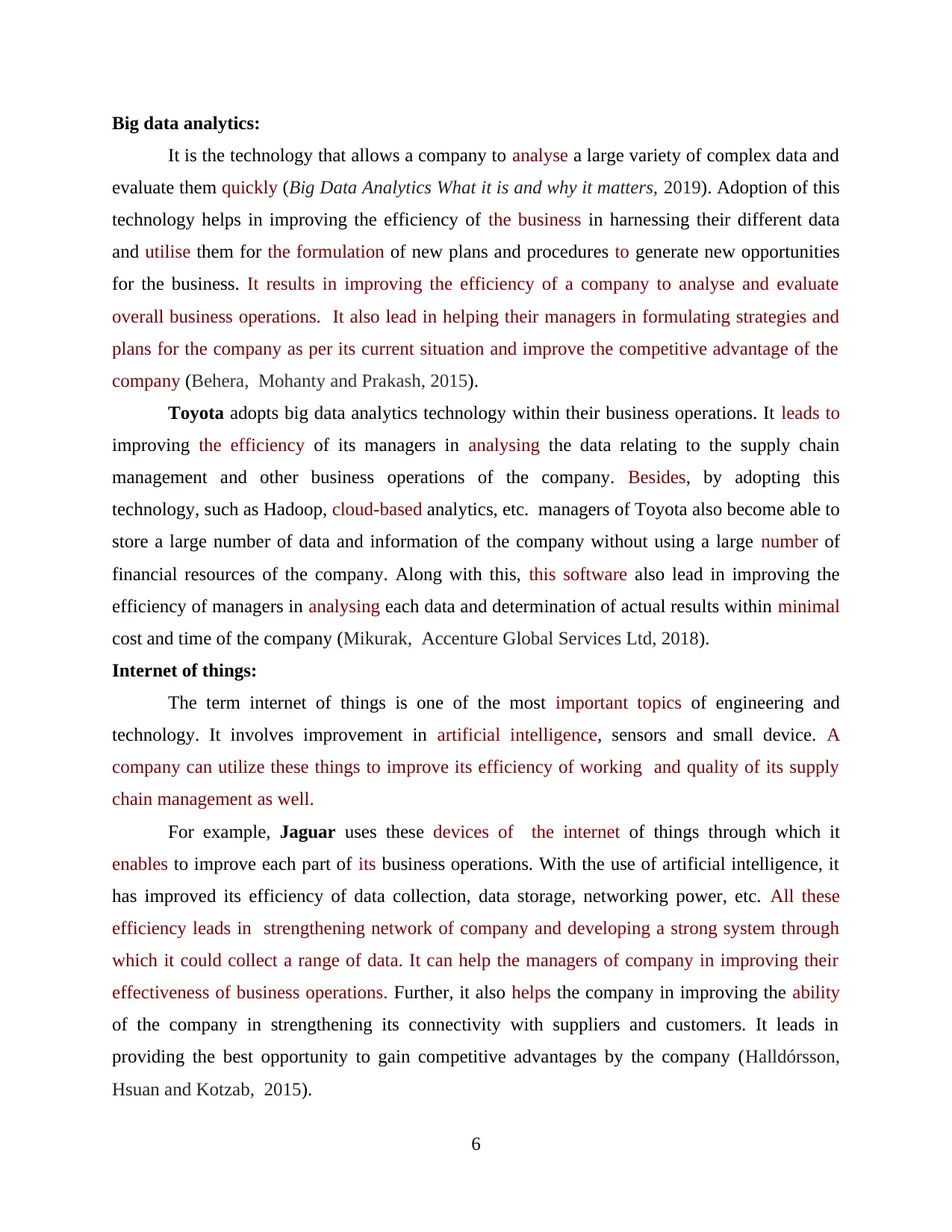
Big data analytics:
It is the technology that allows a company to analyse a large variety of complex data and
evaluate them quickly (Big Data Analytics What it is and why it matters, 2019). Adoption of this
technology helps in improving the efficiency of the business in harnessing their different data
and utilise them for the formulation of new plans and procedures to generate new opportunities
for the business. It results in improving the efficiency of a company to analyse and evaluate
overall business operations. It also lead in helping their managers in formulating strategies and
plans for the company as per its current situation and improve the competitive advantage of the
company (Behera, Mohanty and Prakash, 2015).
Toyota adopts big data analytics technology within their business operations. It leads to
improving the efficiency of its managers in analysing the data relating to the supply chain
management and other business operations of the company. Besides, by adopting this
technology, such as Hadoop, cloud-based analytics, etc. managers of Toyota also become able to
store a large number of data and information of the company without using a large number of
financial resources of the company. Along with this, this software also lead in improving the
efficiency of managers in analysing each data and determination of actual results within minimal
cost and time of the company (Mikurak, Accenture Global Services Ltd, 2018).
Internet of things:
The term internet of things is one of the most important topics of engineering and
technology. It involves improvement in artificial intelligence, sensors and small device. A
company can utilize these things to improve its efficiency of working and quality of its supply
chain management as well.
For example, Jaguar uses these devices of the internet of things through which it
enables to improve each part of its business operations. With the use of artificial intelligence, it
has improved its efficiency of data collection, data storage, networking power, etc. All these
efficiency leads in strengthening network of company and developing a strong system through
which it could collect a range of data. It can help the managers of company in improving their
effectiveness of business operations. Further, it also helps the company in improving the ability
of the company in strengthening its connectivity with suppliers and customers. It leads in
providing the best opportunity to gain competitive advantages by the company (Halldórsson,
Hsuan and Kotzab, 2015).
6
It is the technology that allows a company to analyse a large variety of complex data and
evaluate them quickly (Big Data Analytics What it is and why it matters, 2019). Adoption of this
technology helps in improving the efficiency of the business in harnessing their different data
and utilise them for the formulation of new plans and procedures to generate new opportunities
for the business. It results in improving the efficiency of a company to analyse and evaluate
overall business operations. It also lead in helping their managers in formulating strategies and
plans for the company as per its current situation and improve the competitive advantage of the
company (Behera, Mohanty and Prakash, 2015).
Toyota adopts big data analytics technology within their business operations. It leads to
improving the efficiency of its managers in analysing the data relating to the supply chain
management and other business operations of the company. Besides, by adopting this
technology, such as Hadoop, cloud-based analytics, etc. managers of Toyota also become able to
store a large number of data and information of the company without using a large number of
financial resources of the company. Along with this, this software also lead in improving the
efficiency of managers in analysing each data and determination of actual results within minimal
cost and time of the company (Mikurak, Accenture Global Services Ltd, 2018).
Internet of things:
The term internet of things is one of the most important topics of engineering and
technology. It involves improvement in artificial intelligence, sensors and small device. A
company can utilize these things to improve its efficiency of working and quality of its supply
chain management as well.
For example, Jaguar uses these devices of the internet of things through which it
enables to improve each part of its business operations. With the use of artificial intelligence, it
has improved its efficiency of data collection, data storage, networking power, etc. All these
efficiency leads in strengthening network of company and developing a strong system through
which it could collect a range of data. It can help the managers of company in improving their
effectiveness of business operations. Further, it also helps the company in improving the ability
of the company in strengthening its connectivity with suppliers and customers. It leads in
providing the best opportunity to gain competitive advantages by the company (Halldórsson,
Hsuan and Kotzab, 2015).
6
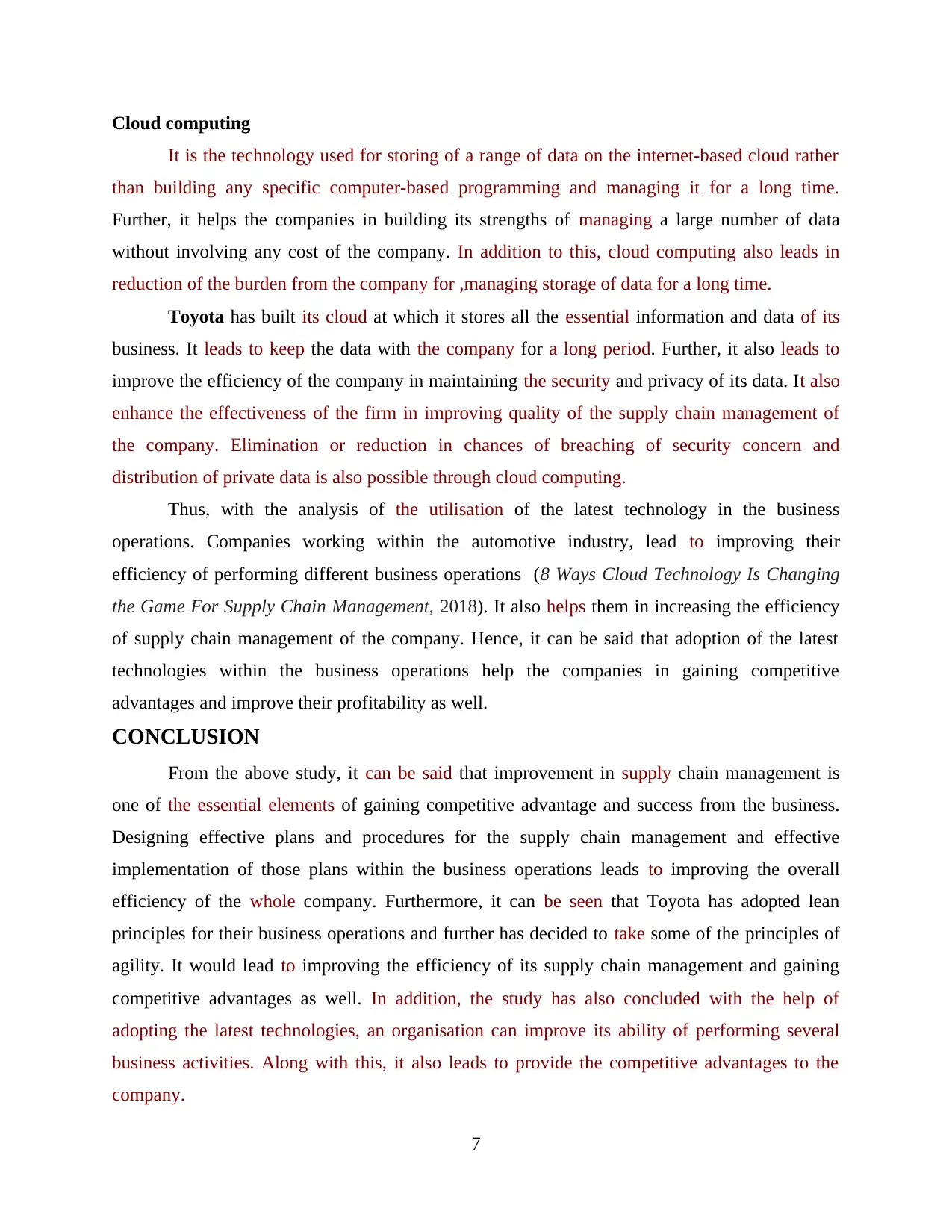
Cloud computing
It is the technology used for storing of a range of data on the internet-based cloud rather
than building any specific computer-based programming and managing it for a long time.
Further, it helps the companies in building its strengths of managing a large number of data
without involving any cost of the company. In addition to this, cloud computing also leads in
reduction of the burden from the company for ,managing storage of data for a long time.
Toyota has built its cloud at which it stores all the essential information and data of its
business. It leads to keep the data with the company for a long period. Further, it also leads to
improve the efficiency of the company in maintaining the security and privacy of its data. It also
enhance the effectiveness of the firm in improving quality of the supply chain management of
the company. Elimination or reduction in chances of breaching of security concern and
distribution of private data is also possible through cloud computing.
Thus, with the analysis of the utilisation of the latest technology in the business
operations. Companies working within the automotive industry, lead to improving their
efficiency of performing different business operations (8 Ways Cloud Technology Is Changing
the Game For Supply Chain Management, 2018). It also helps them in increasing the efficiency
of supply chain management of the company. Hence, it can be said that adoption of the latest
technologies within the business operations help the companies in gaining competitive
advantages and improve their profitability as well.
CONCLUSION
From the above study, it can be said that improvement in supply chain management is
one of the essential elements of gaining competitive advantage and success from the business.
Designing effective plans and procedures for the supply chain management and effective
implementation of those plans within the business operations leads to improving the overall
efficiency of the whole company. Furthermore, it can be seen that Toyota has adopted lean
principles for their business operations and further has decided to take some of the principles of
agility. It would lead to improving the efficiency of its supply chain management and gaining
competitive advantages as well. In addition, the study has also concluded with the help of
adopting the latest technologies, an organisation can improve its ability of performing several
business activities. Along with this, it also leads to provide the competitive advantages to the
company.
7
It is the technology used for storing of a range of data on the internet-based cloud rather
than building any specific computer-based programming and managing it for a long time.
Further, it helps the companies in building its strengths of managing a large number of data
without involving any cost of the company. In addition to this, cloud computing also leads in
reduction of the burden from the company for ,managing storage of data for a long time.
Toyota has built its cloud at which it stores all the essential information and data of its
business. It leads to keep the data with the company for a long period. Further, it also leads to
improve the efficiency of the company in maintaining the security and privacy of its data. It also
enhance the effectiveness of the firm in improving quality of the supply chain management of
the company. Elimination or reduction in chances of breaching of security concern and
distribution of private data is also possible through cloud computing.
Thus, with the analysis of the utilisation of the latest technology in the business
operations. Companies working within the automotive industry, lead to improving their
efficiency of performing different business operations (8 Ways Cloud Technology Is Changing
the Game For Supply Chain Management, 2018). It also helps them in increasing the efficiency
of supply chain management of the company. Hence, it can be said that adoption of the latest
technologies within the business operations help the companies in gaining competitive
advantages and improve their profitability as well.
CONCLUSION
From the above study, it can be said that improvement in supply chain management is
one of the essential elements of gaining competitive advantage and success from the business.
Designing effective plans and procedures for the supply chain management and effective
implementation of those plans within the business operations leads to improving the overall
efficiency of the whole company. Furthermore, it can be seen that Toyota has adopted lean
principles for their business operations and further has decided to take some of the principles of
agility. It would lead to improving the efficiency of its supply chain management and gaining
competitive advantages as well. In addition, the study has also concluded with the help of
adopting the latest technologies, an organisation can improve its ability of performing several
business activities. Along with this, it also leads to provide the competitive advantages to the
company.
7
⊘ This is a preview!⊘
Do you want full access?
Subscribe today to unlock all pages.

Trusted by 1+ million students worldwide
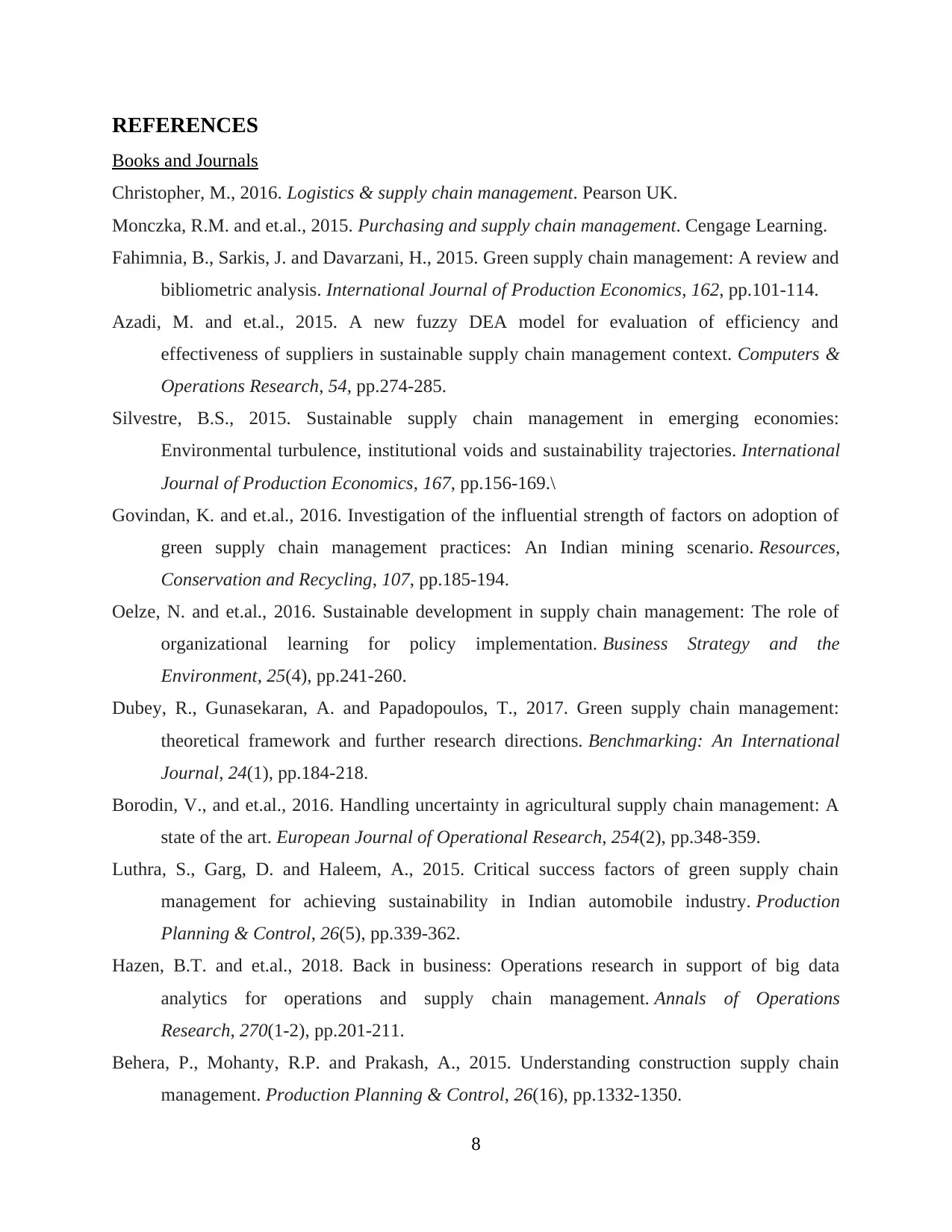
REFERENCES
Books and Journals
Christopher, M., 2016. Logistics & supply chain management. Pearson UK.
Monczka, R.M. and et.al., 2015. Purchasing and supply chain management. Cengage Learning.
Fahimnia, B., Sarkis, J. and Davarzani, H., 2015. Green supply chain management: A review and
bibliometric analysis. International Journal of Production Economics, 162, pp.101-114.
Azadi, M. and et.al., 2015. A new fuzzy DEA model for evaluation of efficiency and
effectiveness of suppliers in sustainable supply chain management context. Computers &
Operations Research, 54, pp.274-285.
Silvestre, B.S., 2015. Sustainable supply chain management in emerging economies:
Environmental turbulence, institutional voids and sustainability trajectories. International
Journal of Production Economics, 167, pp.156-169.\
Govindan, K. and et.al., 2016. Investigation of the influential strength of factors on adoption of
green supply chain management practices: An Indian mining scenario. Resources,
Conservation and Recycling, 107, pp.185-194.
Oelze, N. and et.al., 2016. Sustainable development in supply chain management: The role of
organizational learning for policy implementation. Business Strategy and the
Environment, 25(4), pp.241-260.
Dubey, R., Gunasekaran, A. and Papadopoulos, T., 2017. Green supply chain management:
theoretical framework and further research directions. Benchmarking: An International
Journal, 24(1), pp.184-218.
Borodin, V., and et.al., 2016. Handling uncertainty in agricultural supply chain management: A
state of the art. European Journal of Operational Research, 254(2), pp.348-359.
Luthra, S., Garg, D. and Haleem, A., 2015. Critical success factors of green supply chain
management for achieving sustainability in Indian automobile industry. Production
Planning & Control, 26(5), pp.339-362.
Hazen, B.T. and et.al., 2018. Back in business: Operations research in support of big data
analytics for operations and supply chain management. Annals of Operations
Research, 270(1-2), pp.201-211.
Behera, P., Mohanty, R.P. and Prakash, A., 2015. Understanding construction supply chain
management. Production Planning & Control, 26(16), pp.1332-1350.
8
Books and Journals
Christopher, M., 2016. Logistics & supply chain management. Pearson UK.
Monczka, R.M. and et.al., 2015. Purchasing and supply chain management. Cengage Learning.
Fahimnia, B., Sarkis, J. and Davarzani, H., 2015. Green supply chain management: A review and
bibliometric analysis. International Journal of Production Economics, 162, pp.101-114.
Azadi, M. and et.al., 2015. A new fuzzy DEA model for evaluation of efficiency and
effectiveness of suppliers in sustainable supply chain management context. Computers &
Operations Research, 54, pp.274-285.
Silvestre, B.S., 2015. Sustainable supply chain management in emerging economies:
Environmental turbulence, institutional voids and sustainability trajectories. International
Journal of Production Economics, 167, pp.156-169.\
Govindan, K. and et.al., 2016. Investigation of the influential strength of factors on adoption of
green supply chain management practices: An Indian mining scenario. Resources,
Conservation and Recycling, 107, pp.185-194.
Oelze, N. and et.al., 2016. Sustainable development in supply chain management: The role of
organizational learning for policy implementation. Business Strategy and the
Environment, 25(4), pp.241-260.
Dubey, R., Gunasekaran, A. and Papadopoulos, T., 2017. Green supply chain management:
theoretical framework and further research directions. Benchmarking: An International
Journal, 24(1), pp.184-218.
Borodin, V., and et.al., 2016. Handling uncertainty in agricultural supply chain management: A
state of the art. European Journal of Operational Research, 254(2), pp.348-359.
Luthra, S., Garg, D. and Haleem, A., 2015. Critical success factors of green supply chain
management for achieving sustainability in Indian automobile industry. Production
Planning & Control, 26(5), pp.339-362.
Hazen, B.T. and et.al., 2018. Back in business: Operations research in support of big data
analytics for operations and supply chain management. Annals of Operations
Research, 270(1-2), pp.201-211.
Behera, P., Mohanty, R.P. and Prakash, A., 2015. Understanding construction supply chain
management. Production Planning & Control, 26(16), pp.1332-1350.
8
Paraphrase This Document
Need a fresh take? Get an instant paraphrase of this document with our AI Paraphraser
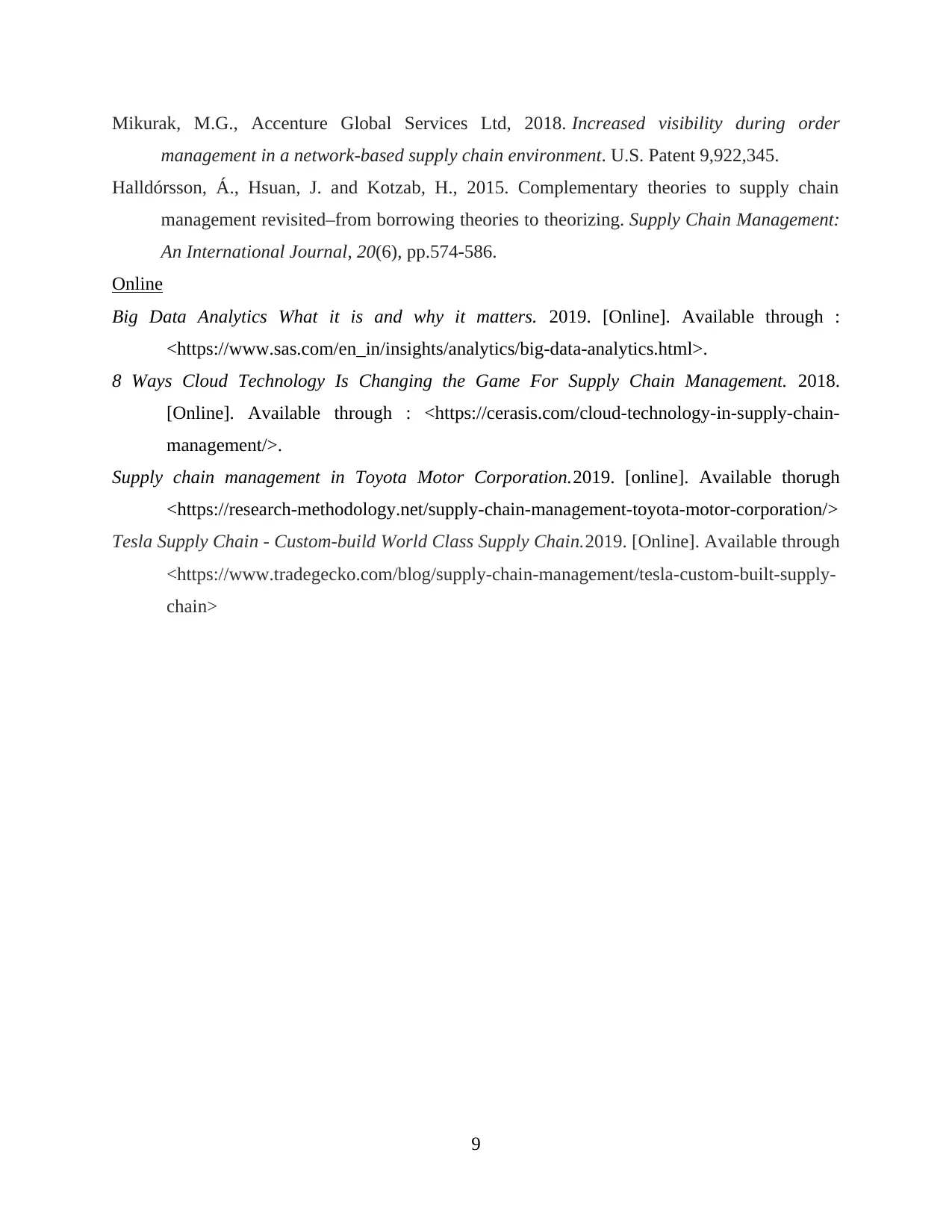
Mikurak, M.G., Accenture Global Services Ltd, 2018. Increased visibility during order
management in a network-based supply chain environment. U.S. Patent 9,922,345.
Halldórsson, Á., Hsuan, J. and Kotzab, H., 2015. Complementary theories to supply chain
management revisited–from borrowing theories to theorizing. Supply Chain Management:
An International Journal, 20(6), pp.574-586.
Online
Big Data Analytics What it is and why it matters. 2019. [Online]. Available through :
<https://www.sas.com/en_in/insights/analytics/big-data-analytics.html>.
8 Ways Cloud Technology Is Changing the Game For Supply Chain Management. 2018.
[Online]. Available through : <https://cerasis.com/cloud-technology-in-supply-chain-
management/>.
Supply chain management in Toyota Motor Corporation.2019. [online]. Available thorugh
<https://research-methodology.net/supply-chain-management-toyota-motor-corporation/>
Tesla Supply Chain - Custom-build World Class Supply Chain.2019. [Online]. Available through
<https://www.tradegecko.com/blog/supply-chain-management/tesla-custom-built-supply-
chain>
9
management in a network-based supply chain environment. U.S. Patent 9,922,345.
Halldórsson, Á., Hsuan, J. and Kotzab, H., 2015. Complementary theories to supply chain
management revisited–from borrowing theories to theorizing. Supply Chain Management:
An International Journal, 20(6), pp.574-586.
Online
Big Data Analytics What it is and why it matters. 2019. [Online]. Available through :
<https://www.sas.com/en_in/insights/analytics/big-data-analytics.html>.
8 Ways Cloud Technology Is Changing the Game For Supply Chain Management. 2018.
[Online]. Available through : <https://cerasis.com/cloud-technology-in-supply-chain-
management/>.
Supply chain management in Toyota Motor Corporation.2019. [online]. Available thorugh
<https://research-methodology.net/supply-chain-management-toyota-motor-corporation/>
Tesla Supply Chain - Custom-build World Class Supply Chain.2019. [Online]. Available through
<https://www.tradegecko.com/blog/supply-chain-management/tesla-custom-built-supply-
chain>
9
1 out of 11
Related Documents
Your All-in-One AI-Powered Toolkit for Academic Success.
+13062052269
info@desklib.com
Available 24*7 on WhatsApp / Email
![[object Object]](/_next/static/media/star-bottom.7253800d.svg)
Unlock your academic potential
Copyright © 2020–2025 A2Z Services. All Rights Reserved. Developed and managed by ZUCOL.





